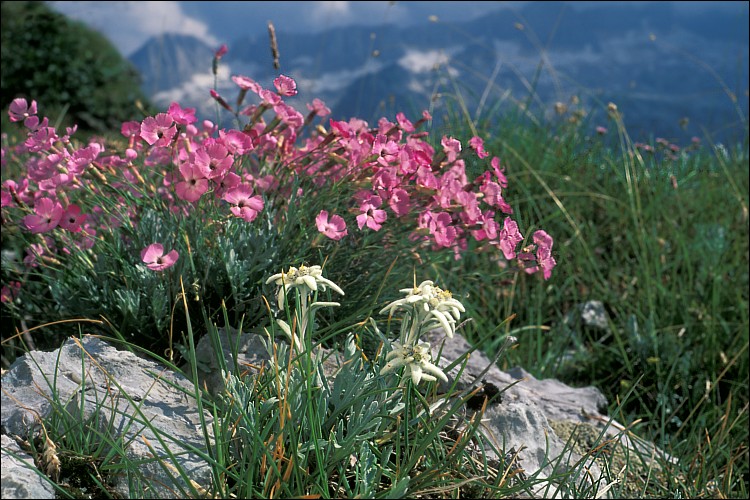Interactions
How does Edelweiss interact with other
organisms, and with which ones does it interact?
In order to survive in their environment, all
organisms must have interactions with other organisms. The symbiotic
relationships that are formed can be positive or negative, but they
are inevitable. Leontopodium alpinum is no exception to this
rule, and the relationships that Edelweiss has with the organisms
around it have helped shaped its role in its environment.
Edelweiss, being an Angiosperm, is a flowering
plant that must be pollinated in order to reproduce (See
Reproduction). In order for this process to occur, there needs to
be a relationship between the flower and a pollinator to transfer
pollen. In this case, the main pollinator is the Muscidae fly. The
relationship is mutualistic, with both organisms benefitting from
the other in order to survive. Muscidae flies eat the nectar inside
of the Edelweiss flower. This causes pollen to collect on the hairs
of the fly and enables it to be transferred to other flowers, thus
pollinating them (Erhardt 1992). The size of the fly also matters to
pollination: “The number of Leontipodium pollen grains found
on the insects increases significantly with increasing body size of
the insect” (Erhardt 1992).
There are no found studies on the predators of
Leontopodium alpinum, however there may be several animals
that feed on the leaves/flowers of the plant. Animals that share
Edelweiss’s habitat include rabbits, deer, stags, and small mammals.
All of these herbivores could eat the Edelweiss plant as a part of
their diet, therefore creating a predatory relationship with
Edelweiss.
One of the major interactions that Edelweiss is
a part of is the relationship it has with humans. The people who
reside in the mountainous regions where Edelweiss is found have been
fascinated by it for centuries. “It is said that more people have
lost their lives trying to collect it than climbing the high peaks
of the Alps” (Erhardt 1992). The fascination with this plant is due
to the medicinal qualities that Edelweiss has. It has been used as
an anti-diarrhea and dysentery cure for many generations (Dobner et
al. 2003). However, there are studies that show that most of the
health qualities of the plant arise due to “the presence and
spectrum of polyphenolic secondary metabolites” (Daniela et al.
2012). These polyphenols have antibacterial and anti-inflammatory
properties (Daniela et al. 2012). The polyphenols are found in the
leaves of the plant, but also in the root systems (Daniela et al.
2012). Leontopodium alpinum has the ability to absorb
ultraviolet rays, scavenge “free radicals”, and antioxidant
properties when used for medicinal purposes (Daniela et al. 2012).
These properties are all very helpful to humans for a variety of
conditions. From skin diseases to stomach conditions, Edelweiss has
been helpful in more ways than one would think.
This relationship Edelweiss has with humans is predatory, because in order for the organism to be used as a beneficial supplement by humans, the plant must be harvested and therefore killed. However, the plant is not necessarily consumed for energy by humans, only harvested for medicinal purposes. The plant is, however, protected in many countries such as Germany, France, Spain, Switzerland, Austria, and Norway (Erhardt 1992).
Back to Home Forward to Fun Facts
Please see the Reference page to see where our information came from.
This page was completed by Peter Tenpas
